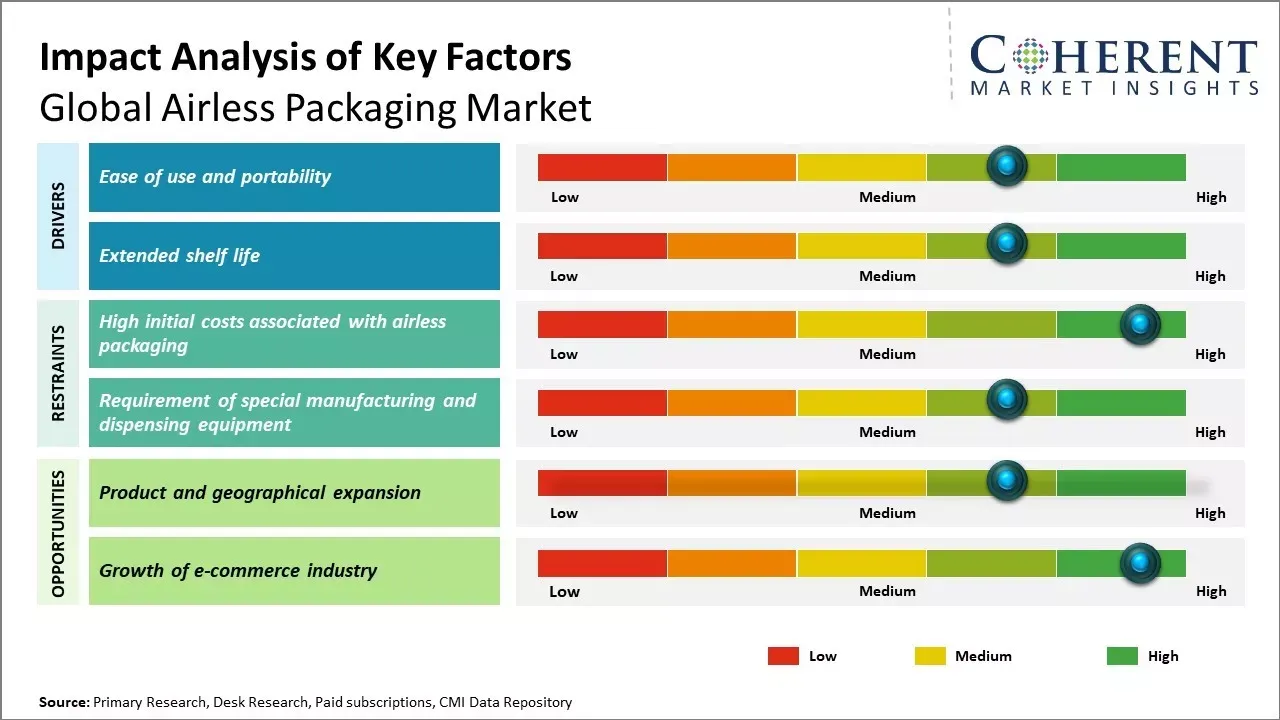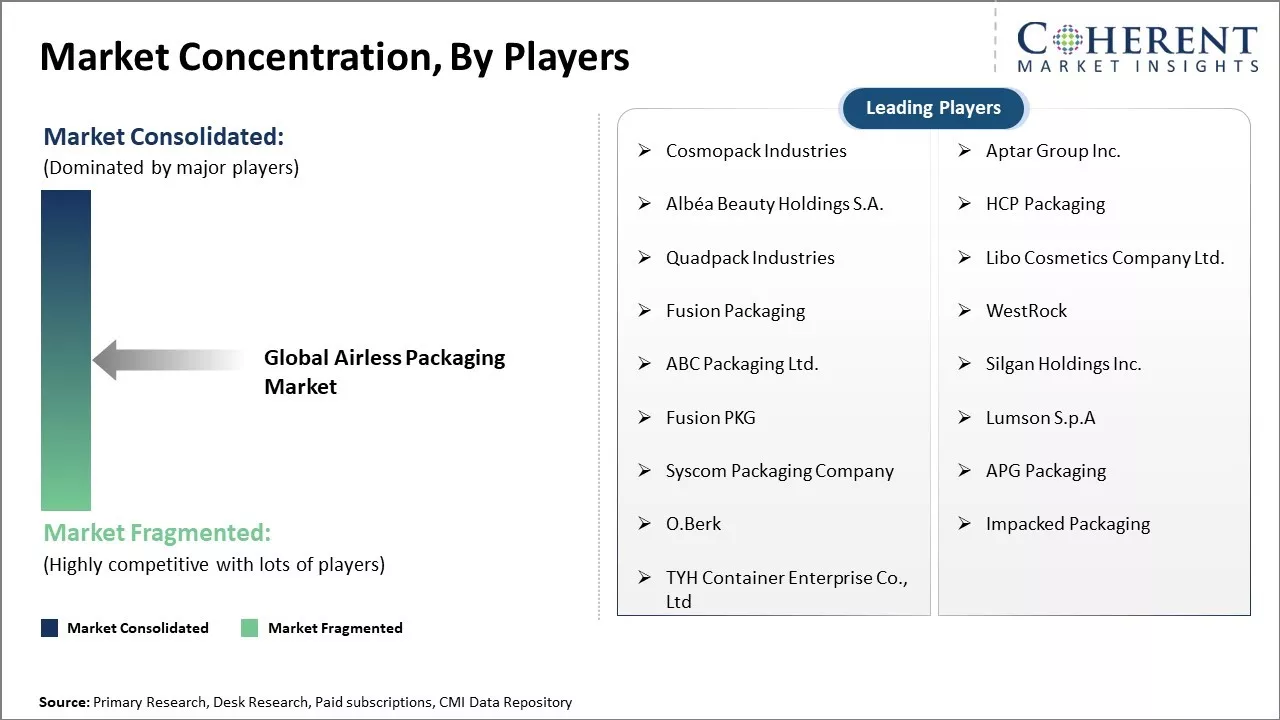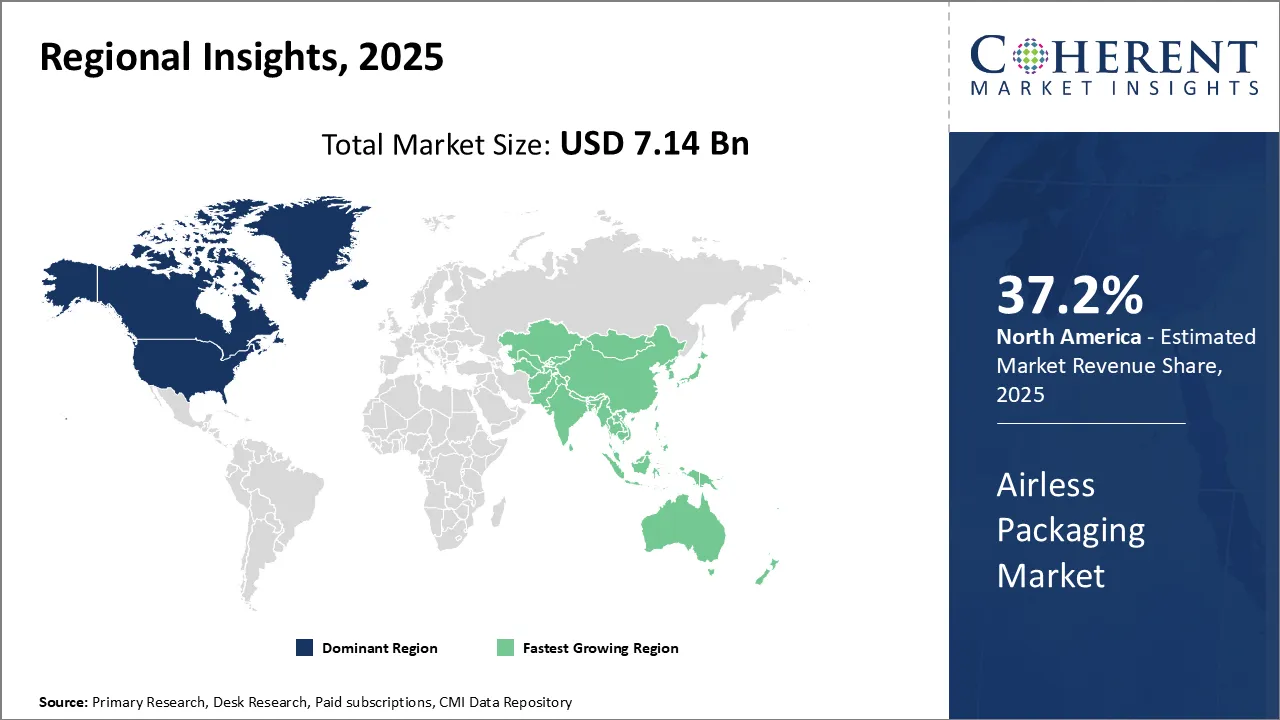The airless packaging market is estimated to be valued at USD 7.14 Bn in 2025 and is expected to reach USD 10.96 Bn by 2032, exhibiting a compound annual growth rate (CAGR) of 6.3% from 2025 to 2032.

To learn more about this report, Download Free Sample
The Airless Packaging Market is anticipated to grow positively during the forecast period. Increased adoption of hygiene packaging solutions with minimal contamination has risen alongside demand from the cosmetics and personal care industries. Airless packaging is beneficial in protecting products from external contamination, preventing leakage and spillage as well as wastage. It prevents the need for preservatives while keeping products fresh, increasing their shelf life.
For example, airless pump bottles are increasingly being adopted by cosmetic companies such as Estée Lauder and L'Oréal. These companies have adopted airless packaging to improve the purity and freshness of their skincare products, reducing the need for preservatives and ensuring longer shelf life which is aligned with consumer demand for contamination-free products.
|
Event |
Description and Impact |
|
Global Supply Chain Disruptions and Raw Material Shortages |
|
|
Sustainability Regulations and Environmental Initiatives |
|
|
Technological Advancements in Packaging Innovation |
|
Uncover macros and micros vetted on 75+ parameters: Get instant access to report
The global airless packaging market, valued at around $5.2 billion in 2023, exhibits diverse pricing driven by material quality, packaging volume, technology, and brand positioning. Airless packaging without spring mechanisms is gaining traction due to simpler designs and cost efficiency, appealing especially to mass-market and e-commerce brands seeking affordability with reliable product protection.
In vacuum sealing applications, airless packaging ensures product freshness by eliminating air exposure, which supports premium pricing for cosmetics and pharmaceuticals. Airless packaging with dispensing accuracy is a key feature commanding higher prices, particularly in advanced multi-chamber and sensor-integrated dispensers used by luxury brands.
Pricing varies by segment: luxury cosmetics using airless pump bottles (30ml-50ml) range from $8.50 to $15 per unit, while mid-tier and mass-market options offer more cost-effective solutions starting at $2.50 per unit. Personal care products, including skincare serums and men’s grooming lines, reflect similar pricing scales, balancing preservation needs with affordability.
E-commerce brands prefer airless packaging solutions optimized for shipping durability and consumer convenience, often opting for mid-tier materials and volumes. Overall, the market pricing balances innovation, material choice, and end-use requirements, with continuous shifts toward sustainable and precise dispensing technologies.
Key innovations in product preservation systems as well as the user experience are advancing the airless packaging industry. Equipped with micro-pump systems and vacuum-based diaphragms, dispensing systems allow for full and sterile evacuation of the product and precise dosing. For low viscosity skincare products, flow rate is optimized with smart dispensing systems that use pressure sensors to control pressure relative to product thickness.
Nanotechnology is being used to create multi-layer barrier composites that shield products from oxygen, moisture, and light; these are also biodegradable and bio-based polymers like corn-starch and algae, thus addressing environmental concerns.
Smart packaging enables monitoring, authentication, and consumer interaction with products via IoT, NFC, and RFID technologies which permits real-time tracking of product usage. Recent advancements allow for the production of compact, travel-friendly airless containers that are sealed with ultrasonic and laser techniques to ensure product safety. Through digital printing and surface treatment, customization enhances brand perception.
An increase in efficiency and precision is noted through automated manufacturing, robotic assembly, and multi-shot molding; these innovations result in more functional and accessible airless packaging in the cosmetics, pharmaceuticals, and personal care sectors.
Compliance with safety, environmental, and resource restrictions impacts the airless packaging industry. Agencies like the FDA and EMA require stringent compliance for the healthcare and pharmaceutical sterile packaging due to hygiene and safety concerns for the end-users. There are restrictions on the use of environmentally damaging materials like single-use plastics which need to be replaced with more recyclable and biodegradable alternatives.
Countries in North America and Europe are also enforcing the use of recyclable materials in packaging—forcing manufacturers to come up with new sustainable airless packaging options.
There are also regulations about disclosing material used in a product which impacts advertising and recourse used in packaging. Trade policies, import-export tariffs, and the governed laws of raw material utilized and the location of manufacturing greatly influence the overall cost and supply structure.
Market players who are looking to stay competitive and legal compliant bound have to follow the regulations as outlined. With the constant change in emissions and legal frameworks, the use of environmentally sustainable options is anticipated to rise as these pressures slow down innovation in the use of airless packaging technologies.

To learn more about this report, Download Free Sample
The airless packaging system provides great convenience to consumers as it eliminates the need to pump or squeeze the product container in order to dispense the content. With airless packaging, one simply needs to press the nozzle to release the desired amount of product in a clean and mess-free manner. This prevents accidental squeezing that could cause wastage of product. The package shape and size can also be customized as per the product attributes and desired volume, which makes handling and storage very convenient.
Furthermore, the lightweight and compact design of airless containers make them highly portable. Travel-sized airless bottles are a huge hit in the cosmetic industry as consumers prefer packing minimally while travelling. Airless packaging gives the freedom to carry one's daily skincare or makeup essentials discreetly without worrying about spills or leaks.
Sports personalities appreciate the portability of airless squeeze tubes to carry nutrition supplements or pain relief balms while on the go. With their leak proof nature, airless containers can even survive the bounces and jerks experienced in carry-on luggage or backpack during transit. Their portability makes them a natural choice for on-the-go lifestyles adopted by millennials and generation Z consumers.
Unlike conventional packaging types that rely on the entrapment of air inside the headspace to dispense products, airless systems do not provide entry to air and other external contaminants once the package is sealed. This property effectively helps preserve the quality and integrity of even the most sensitive formulations that are prone to degradation upon exposure to oxygen, moisture and microbes. Products containing natural extracts and active ingredients have better stability and extended shelf life when packaged in airless containers.
Furthermore, the pinch technology employed in airless dispensing prevents wastage by extracting every last drop of product from the package. Consumers appreciate getting full value for money without any leftover residue. Manufacturers also save significantly on production overheads by minimizing giveaways.
This translates to freshness assurance for longer durations till the package is completely emptied. The barrier against external factors ensures brand loyalty gets strengthened as consumers continue receiving consistent performance from products well past their usual expiration dates.
The airless packaging market has a great opportunity for product and geographical expansion in the coming years. Currently airless packaging is used majorly for skin care and cosmetic products due to its ability to prevent contamination and prolong the shelf life of the products. However, with continuous innovation and development of improved airless systems, these packaging solutions can be effectively utilized for other personal care and healthcare products as well.
Various new formulations are being developed for conditions like hair fall, anti-dandruff, wound care, etc. that require specific delivery methods and prevention of contamination. Airless packaging ensures sterile and more accurate dosage of such products without any wastage. This enhances patient compliance especially for prescription medications.
Many leading brands are researching the development of airless systems for ointments, gels and liquids used for muscle, joint pains, and other therapy solutions. The successful adoption of such customized airless packs will open newer opportunities in the pharmaceutical and healthcare segments.
In terms of packaging type, bottles & jars is expected to contribute 56.1% share of the market in 2025, owing to their portability and ease of use. As consumers lead increasingly busy lifestyles with less time to spend on daily tasks like personal care routines, bottles and jars have become popular for their convenience. Their design allows for simple one-handed dispensing of liquid or cream products without needing to transfer contents between containers. This makes them ideal for on-the-go use, whether at home or traveling.
Many personal care items packaged in bottles and jars also promote the perception of a fresher product. Since the contents are not exposed to air, bottles and jars help shield cosmetics, haircare treatments, and more from potential contamination versus plastic tubs or open containers. The airtight seal appeals to consumers looking for hygienic, long-lasting formulations. Bottles and jars are also recyclable, adding to their sustainable appeal.
For brands, bottles and jars provide ample surface space to feature colorful labels, trademarks, and branding that grabs consumer attention on packed shelves. Their contours allow for creative shapes and designs that differentiate products from competitors. The accessibility of contents also increases potential per-use consumption versus larger tubs or pouches. Overall, bottles and jars satisfy demands for protective, portable, and pragmatic packaging across multiple categories within the airless personal care and home care industries.
In terms of material type, plastics is expected to contribute 49.1% share of the market in 2025, due to its cost advantages over its alternatives. Plastic is relatively inexpensive to produce on a large scale compared to glass, metal, or other materials. It requires less energy to manufacture and package many liquid or creamy formulas. The cost benefits are particularly appealing for mass consumer brands seeking affordable solutions.
Additionally, plastic is lightweight yet durable, making it a practical choice for packaging. It withstands dropping or minor impacts better than more fragile materials. Plastic bottles, jars, tubes and other containers are also corrosion-resistant without needing protective coatings. This enhances shelf life for products.
From a production standpoint, plastic is highly versatile. Molding capabilities allow complex package shapes that show off brands' creativity while maintaining functionality. Its permeability properties can be designed for specific formulation needs like moisture control. An array of plastic types expands options for visual effects, tactile texture, and closure or dispensing mechanisms.
As recycling capabilities evolve, plastic has grown less controversial from an eco-perspective versus past perceptions. Its predominance in the airless packaging space remains steady given balancing performance needs with accessible pricing across socioeconomic consumer classes.
In terms of end user, personal care is expected to contribute 55.1% share of the market in 2025, as airless packaging exceptionally benefits cosmetic and skincare product formulations. For consumers, the airtight barrier of bottles, jars, tubes, and other containers protects active ingredients from degradation form exposure to air, light, and other environmental factors over time. This translates to longer-lasting products that maintain potency between uses.
From a branding and experience perspective, airless packaging promotes perceptions of premium quality for personal care brands. Its effectiveness at preventing leakage or spillage adds to the reassurance of hygienic formulas, while creative bottle shapes enhance the luxury element. Unique pump or flip-top dispensing mechanisms provide satisfying tactile interactions that reinforce a product's value.
Minimizing contact between formulation and exterior container surfaces safeguards against contamination of cosmetics meant for direct application. Properties like portability facilitate touch-ups and multi-step routines outside the home. All of these strengths create maximum advantage for personal care companies to showcase innovative science-backed formulations.
Airless packaging also optimizes product usage versus alternative formats. Consumers extract every last drop without excess exposure that could degrade more delicate skincare actives. This protects investments in high-performance, results-driven formulations. Overall, personal care leverages airless packaging advantages better than other industry verticals.

To learn more about this report, Download Free Sample
North America currently leads the global airless packaging market, expected to hold approximately 37.2% of the market share in 2025. The region’s dominance is largely attributed to the strong presence of the cosmetics industry in countries such as the United States and Canada.
Major beauty and skincare brands headquartered in North America extensively rely on airless packaging solutions to securely protect their premium products from contamination and oxidation. Consumer demand for sustainable and zero-waste packaging further bolsters the preference for airless systems, reflecting growing environmental consciousness in the region.
Additionally, stringent regulatory frameworks focused on packaging sustainability and resource efficiency drive innovation and adoption of eco-friendly packaging solutions. North America also benefits from robust export demand, with significant volumes of airless-packaged cosmetics shipped to markets in Asia Pacific and Europe. This export strength is supported by well-established manufacturing capabilities and superior product quality maintained by leading North American airless packaging producers.
Asia Pacific has emerged as the fastest-growing region in the global airless packaging market, fueled by rapid growth in countries like India, China, South Korea, and Indonesia. The expanding domestic cosmetics industry, supported by rising disposable incomes among the middle class, is creating abundant opportunities for airless packaging adoption. Shifting consumer lifestyles and heightened focus on personal care are driving demand for innovative, high-quality packaging that enhances product shelf life and user experience.
The region enjoys a competitive cost advantage in production due to the extensive presence of raw material suppliers and packaging converters, enabling manufacturers to deliver economically priced solutions to both domestic and international brand owners. Additionally, relatively less stringent regulatory environments in several emerging Asia Pacific markets have historically accelerated the adoption of advanced packaging technologies such as airless packaging, compared to more regulated regions.
The United States anchors North America’s airless packaging market with its concentration of global cosmetic giants and premium skincare brands. The U.S. market is propelled by consumer demand for sustainable, innovative packaging solutions that enhance product efficacy and brand image.
Regulatory pressures around waste reduction and resource efficiency also encourage manufacturers to invest heavily in airless technologies. Leading American manufacturers continuously innovate to meet both domestic and export demands, making the U.S. a pivotal player in the global airless packaging landscape.
Canada contributes significantly to the North American market, driven by a strong beauty and personal care industry and increasing environmental awareness among consumers. Canadian brands prioritize packaging solutions that align with sustainability goals, fueling demand for airless packaging. Additionally, cross-border trade with the U.S. supports manufacturing and distribution efficiencies, reinforcing Canada’s role in the region’s airless packaging ecosystem.
China stands as a major growth engine in the Asia Pacific airless packaging market, buoyed by a booming cosmetics industry and a large consumer base eager for premium beauty products. The country’s rapidly evolving packaging manufacturing sector benefits from extensive raw material availability and cost-effective production capabilities. Government initiatives supporting modernization of packaging standards and quality control also facilitate faster adoption of airless packaging technologies across domestic brands.
India’s airless packaging market is expanding swiftly alongside its growing cosmetics and personal care sectors. Rising disposable incomes and increasing urbanization are driving consumer preference for hygienic and sustainable packaging options. Local manufacturers leverage the region’s raw material supply chains and packaging converter networks to offer competitive pricing and scalable production, supporting both domestic growth and export potential. The relatively relaxed regulatory framework compared to developed markets has enabled faster market penetration of innovative packaging formats such as airless systems.
| Report Coverage | Details | ||
|---|---|---|---|
| Base Year: | 2024 | Market Size in 2025: | USD 7.14 Bn |
| Historical Data for: | 2020 To 2024 | Forecast Period: | 2025 To 2032 |
| Forecast Period 2025 to 2032 CAGR: | 6.3% | 2032 Value Projection: | USD 10.96 Bn |
| Geographies covered: |
|
||
| Segments covered: |
|
||
| Companies covered: |
Cosmopack Industries, Aptar Group Inc., Albéa Beauty Holdings S.A., HCP Packaging, Quadpack Industries, Libo Cosmetics Company Ltd., Fusion Packaging, WestRock, ABC Packaging Ltd., Silgan Holdings Inc., Fusion PKG, Lumson S.p.A, Syscom Packaging Company, APG Packaging, O.Berk, Impacked Packaging, and TYH Container Enterprise Co., Ltd. |
||
| Growth Drivers: |
|
||
| Restraints & Challenges: |
|
||
Uncover macros and micros vetted on 75+ parameters: Get instant access to report
Share
Share
About Author
Pankaj Poddar is a seasoned market research consultant with over 12 years of extensive experience in the fast-moving consumer goods (FMCG) and plastics material industries. He holds a Master’s degree in Business Administration with specialization in Marketing from Nirma University, one of India’s reputed institutions, which has equipped him with a solid foundation in strategic marketing and consumer behavior.
As a Senior Consultant at CMI for the past three years, he has been instrumental in harnessing his comprehensive understanding of market dynamics to provide our clients with actionable insights and strategic guidance. Throughout his career, He has developed a robust expertise in several key areas, including market estimation, competitive analysis, and the identification of emerging industry trends. His approach is grounded in a commitment to understanding client needs thoroughly and fostering collaborative relationships. His dedication to excellence and innovation solidifies his role as a trusted advisor in the ever-evolving landscape of not only FMCG but also chemicals and materials markets.
Missing comfort of reading report in your local language? Find your preferred language :
Transform your Strategy with Exclusive Trending Reports :
Frequently Asked Questions
Joining thousands of companies around the world committed to making the Excellent Business Solutions.
View All Our Clients